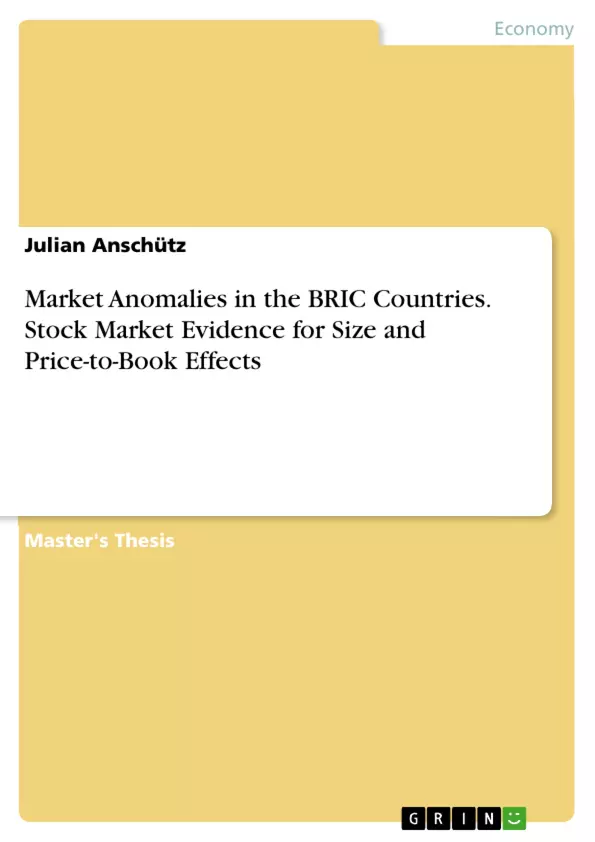In order to fill a gap in the research on developing equity markets, especially emerging markets, this study deals with market anomalies in the BRIC countries, specifically focusing on identifying the anomalies size and price-to-book effect.
However, the reason for an analysis regarding stock market anomalies in the BRIC countries is not exclusively limited to the lack of contemporary studies on this topic. The emerging markets in general, and, specifically, the BRIC stock markets are very interesting and valuable objects for respective examinations, since they still provide an enormous growth potential. The markets naturally show a high volatility.
This study’s approach is to explain the established market anomalies and point at factors, which may enforce size and price-to-book effects in each BRIC country. Therefore, after presenting the BRIC concept in chapter 2, the standard method to estimate the stock return, the Capital
Asset Pricing Model (CAPM), is introduced in chapter 3 in order to identify possible weaknesses and certain anomalies, which have been identified in the research. The most common anomalies will be introduced in chapter 4. Subsequently, an alternative method to explain the stock return, the Fama / French three-factor model is discussed as a possibility to identify further risk factors, which can invalidate anomalies with respect to the CAPM, in chapter 5. Furthermore, a brief overview on previous studies, which include valuation anomalies in the respective countries, is given in chapter 6. In the empirical part of chapter 7, each country is analyzed individually with respect to size and price-to-book effects. However, the study applies the same empirical analysis for each stock market in order to obtain comparable results, choosing a timespan, which covers the maximum period for which sufficient data is available in all stock markets. Two approaches are used per country. The first, to identify the mentioned stock market anomalies, the second to explain the cross-section of stock returns by means of three proxies for risk, namely systematic risk in form of CAPM-beta, size and book-to-market equity ratio. The empirical part of this examination investigates the time frame from January 1996 until June 2015 and uses a total sample of 6,054 stocks throughout the four stock markets. In the conclusion, the study’s results are summarized and findings presented.
Inhaltsverzeichnis (Table of Contents)
- Introduction
- The BRIC Concept
- Introducing the BRIC Countries
- Heterogeneous Conditions
- Volatility of the Investors' Interest in the BRIC Markets
- Theoretical Background of Stock Market Anomalies
- Stock Market Anomalies – Definition
- Capital Market Model - CAPM
- The Model
- Theory of Efficient Markets
- Criticism of the CAPM
- Conditions for Anomalies in the BRIC Countries
- Market Efficiency in the BRIC Countries
- Brazil
- Russia
- India
- China
- Hypothesis
- Stock Market Anomalies
- Valuation Anomalies
- Size Effect
- Price-to-Book Effect / Book-to-Market Effect
- Price-Earnings-Ratio Effect
- Calendar Anomalies
- January Effect and Weekend Effect
- Can further Risk Factors Invalidate Valuation Anomalies?
- Fama and French's Multi-Factor Model - Approach
- Fama and French's Three-Factor Model
- Research Overview - Valuation Anomalies in the BRIC Countries
- Brazil
- Russia
- India
- China
- Size and Price-to-Book Effect Analysis
- Data and Methodology
- Data
- Methodology
- Examination of the Brazilian Stock Market
- The Brazilian Sample
- Empirical Evidence for the Brazilian Stock Market
- Examination of the Russian Stock Market
- The Russian Sample
- Empirical Evidence for the Russian Stock Market
- Examination of the Indian Stock Market
- The Indian Sample
- Empirical Evidence for the Indian Stock Market
- Examination of the Chinese Stock Market
- The Chinese Sample
- Empirical Evidence for the Chinese Stock Market
- Discussion
Zielsetzung und Themenschwerpunkte (Objectives and Key Themes)
This thesis aims to explore the presence of stock market anomalies in the BRIC countries. The research focuses on two specific anomalies: the size effect and the price-to-book effect. The study investigates whether these anomalies persist in these emerging markets, considering their unique characteristics and development stages.
- Stock market anomalies in emerging markets
- The size effect and price-to-book effect in the BRIC countries
- Market efficiency and its implications for anomaly persistence
- Empirical analysis of stock market data in Brazil, Russia, India, and China
- The impact of risk factors on anomaly performance
Zusammenfassung der Kapitel (Chapter Summaries)
The thesis begins by introducing the BRIC concept and outlining the unique characteristics and challenges of these emerging economies. It then delves into the theoretical background of stock market anomalies, explaining the concept of market efficiency and the CAPM model. The study also examines the specific conditions that might contribute to the existence of anomalies in the BRIC countries.
Chapter 4 focuses on the two main anomalies under investigation: the size effect and the price-to-book effect. The chapter explains the theoretical underpinnings of these anomalies and their potential implications for investors. Chapter 5 explores the role of risk factors in potentially invalidating these anomalies, introducing Fama and French's multi-factor model as a framework for analysis.
Chapters 6 and 7 present a research overview and empirical analysis of the size and price-to-book effects in the BRIC countries. The study examines each country individually, providing detailed data and methodology, as well as empirical evidence for the presence or absence of these anomalies. Chapter 7 concludes with a discussion of the findings and their implications for investors and policymakers.
Schlüsselwörter (Keywords)
The main keywords and focus topics of this thesis include stock market anomalies, BRIC countries, size effect, price-to-book effect, market efficiency, emerging markets, empirical analysis, risk factors, Fama and French's multi-factor model, and investment strategies.
- Citation du texte
- Julian Anschütz (Auteur), 2016, Market Anomalies in the BRIC Countries. Stock Market Evidence for Size and Price-to-Book Effects, Munich, GRIN Verlag, https://www.grin.com/document/343037



